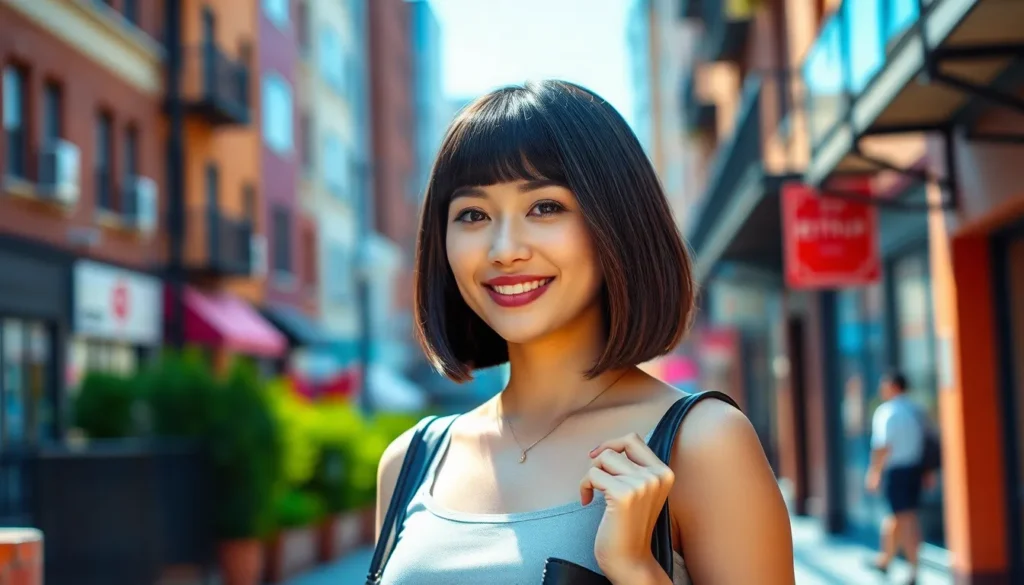We’ve all dreamed of that perfect haircut that transforms our entire look – and short bob hairstyles consistently deliver that magical transformation. These versatile cuts have dominated fashion runways and city streets alike because they offer the perfect blend of sophistication and effortless style that works for virtually every face shape and lifestyle.
Whether you’re craving a dramatic change or simply want to refresh your current look, short bobs provide endless possibilities. From sleek and polished to textured and tousled, these cuts can be customized to reflect your personality while maintaining that timeless appeal that never goes out of style.
We’re about to explore the most stunning short bob variations that’ll have you booking your salon appointment before you finish reading. Get ready to discover which short bob style will become your signature look and learn the styling secrets that’ll keep you looking effortlessly chic every single day.
Classic Bob: The Timeless Foundation of Short Bob Hairstyles
The classic bob serves as the cornerstone of all short bob variations, establishing the fundamental structure that makes this hairstyle eternally appealing. We’ve seen this foundational cut evolve through decades while maintaining its essential characteristics that define modern bob hairstyles.
Chin-Length Precision Cut
Chin-length precision cuts create the most recognizable silhouette in short bob hairstyles, falling perfectly at jawline level for maximum impact. We recommend this length because it enhances facial features while providing enough hair to experiment with different textures and finishes. Professional stylists typically use point cutting techniques to achieve the precise edges that make this cut so distinctive.
The measurement typically ranges from 4 to 6 inches in length, depending on individual neck proportions and face shape considerations. We’ve found that this exact length works exceptionally well for women with oval, square, and heart-shaped faces. Maintenance appointments every 6 to 8 weeks keep the precision cut looking sharp and well-defined.
Straight-Across Blunt Ends
Straight-across blunt ends deliver the strongest visual statement in classic bob styling, creating clean horizontal lines that emphasize the cut’s geometric precision. We achieve this look through careful sectioning and razor-sharp cutting techniques that eliminate any graduation or layering. The blunt finish adds substantial weight to hair ends, making fine hair appear thicker and more voluminous.
Blunt cuts work particularly well on naturally straight to slightly wavy hair textures, as they showcase the clean line without interference from natural curl patterns. We often recommend this style for women seeking a bold, confident look that photographs beautifully. The straight edge requires minimal styling effort once the initial cut is perfected.
Versatile Styling Options
Versatile styling options make the classic bob adaptable to various occasions and personal preferences throughout the week. We can transform the same cut from sleek and professional to textured and casual using different styling products and techniques. Heat styling tools like flat irons create smooth, polished looks, while texturizing sprays add movement and body.
Popular styling variations include tucking one side behind the ear for asymmetrical appeal, adding loose waves with a curling iron, or creating volume at the crown with round brush blow drying. We’ve discovered that lightweight styling products work best to maintain the bob’s natural movement without weighing down the hair. Quick touch-ups with dry shampoo extend the style between washes while adding beneficial texture.
A-Line Bob: Creating Shape and Movement

The A-line bob represents a modern evolution of the classic bob, offering dimensional styling that flatters virtually every face shape. This sophisticated variation creates visual interest through strategic length differences that enhance natural movement.
Shorter Back, Longer Front Design
Graduated layers form the foundation of the A-line bob’s distinctive silhouette. The back section typically measures 1 to 2 inches shorter than the front pieces, creating an elegant slope that follows your jawline. Professional stylists cut the hair at precise angles, ensuring each layer flows seamlessly into the next for optimal shape retention.
This length variation adds sophisticated dimension to otherwise flat hair textures. Fine hair benefits particularly from this technique, as the graduated cutting creates the illusion of fuller, thicker strands throughout. Medium to thick hair types showcase enhanced movement and reduced bulk in the back section, preventing the heaviness often associated with traditional blunt cuts.
Face-Framing Angles
Strategic angling transforms the A-line bob into a universally flattering style choice. The longer front pieces elongate round faces while softening angular jawlines on square face shapes. Oval faces gain added structure from the geometric precision of the cut’s natural lines.
Customized angle degrees allow for personal adaptation based on individual preferences. Subtle angles measuring 15 to 20 degrees create gentle face framing effects, while dramatic angles of 30 degrees or more produce bold, statement making looks. Your stylist can adjust these measurements to complement your bone structure and lifestyle requirements.
The angled front sections draw attention upward toward your eyes and cheekbones. This natural highlighting effect eliminates the need for heavy makeup contouring while creating photogenic appeal from every viewing angle.
Volume-Boosting Benefits
Layered construction naturally amplifies hair volume without requiring extensive styling products. The shorter back section creates lift at the crown area, adding height that makes fine hair appear significantly fuller. This architectural approach to volume lasts throughout the day, unlike temporary answers from mousses or sprays.
Root lifting occurs automatically due to the weight distribution differences between sections. The graduated lengths prevent hair from falling flat against your scalp, maintaining dimensional shape even in humid conditions. Regular maintenance every 6 to 8 weeks preserves these volume improving properties.
Styling versatility increases dramatically with this structural foundation. Air drying produces natural texture and movement, while blow drying with a round brush enhances the volume boosting effects. Heat styling tools like flat irons and curling wands work more effectively on the varied lengths, creating long lasting styles with minimal product application.
Pixie Bob: The Edgy Short Bob Alternative

While traditional bobs maintain length around the chin area, pixie bobs break boundaries by combining the structured elements of classic bobs with the daring brevity of pixie cuts.
Ultra-Short Length Appeal
Pixie bobs revolutionize short hair styling by offering maximum impact with minimal length. These cuts typically measure 2 to 4 inches at their longest points, creating dramatic transformation potential for those seeking bold change. Face shapes benefit differently from this ultra-short approach, with oval and heart-shaped faces showcasing the most flattering results.
Styling time decreases significantly with pixie bob lengths, requiring only 5 to 10 minutes for complete preparation. Morning routines become streamlined as the shortened length eliminates extensive blow drying and complex styling techniques. Professional settings welcome this polished yet contemporary look, making pixie bobs ideal for busy lifestyles.
Maintenance schedules intensify with pixie bob cuts, necessitating salon visits every 4 to 6 weeks. Growth patterns become more noticeable at shorter lengths, particularly around the nape and ear areas. Investment in regular trims ensures the structured silhouette remains sharp and intentional.
Textured Choppy Layers
Layering techniques create dimensional movement within pixie bob structures, preventing flat or lifeless appearances. Choppy cuts add rebellious energy while maintaining sophisticated undertones suitable for various age groups. Hair textures from fine to thick benefit from strategic layer placement that enhances natural volume patterns.
Razored edges produce the coveted choppy texture that defines modern pixie bob styling. Stylists use point cutting methods to create irregular lengths that catch light differently throughout the day. These techniques work exceptionally well on straight to slightly wavy hair types, adding visual interest without requiring product manipulation.
Asymmetrical elements within choppy layers offer personalization opportunities for individual style expression. Longer sections can frame exact facial features while shorter areas provide edgy contrast. Color techniques like highlights or lowlights become more pronounced within textured pixie bob cuts, creating additional depth and movement.
Low-Maintenance Styling
Product requirements minimize dramatically with pixie bob cuts, often needing only lightweight texturizing sprays or small amounts of styling paste. Air drying becomes a viable option for most hair types, eliminating daily heat tool dependency. Natural texture emerges more prominently at shorter lengths, reducing the need for extensive manipulation.
Styling versatility remains surprisingly extensive even though the abbreviated length, allowing for sleek professional looks or tousled casual styles. Finger styling techniques prove most effective for pixie bobs, using small amounts of product distributed through damp hair. Evening transformations require minimal effort, with slight product reapplication creating entirely different aesthetics.
Weather resistance improves significantly with pixie bob lengths, as shorter hair maintains its shape better in humid or windy conditions. Swimming and active lifestyles become more manageable since the reduced length dries quickly and reforms easily. Travel preparation simplifies considerably, as pixie bobs require fewer styling tools and products for maintenance away from home.
Inverted Bob: Bold and Dramatic Short Cuts
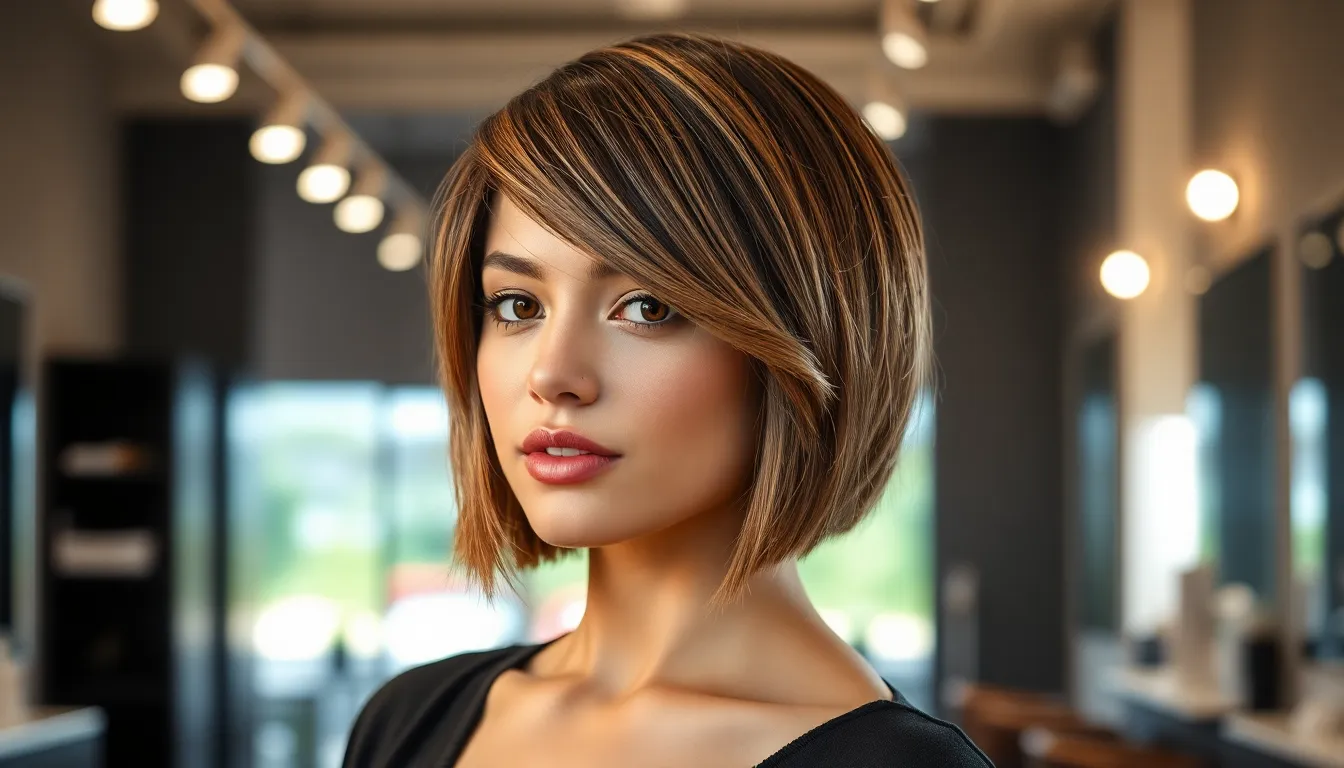
Inverted bobs represent the boldest evolution of short bob hairstyles, delivering maximum visual impact through strategic length manipulation. We’ll explore how this daring cut transforms traditional bob principles into head-turning statements.
Stacked Back Layers
Stacked layers create the signature silhouette that defines inverted bob excellence. Multiple graduated layers build upon each other at the back, starting with the shortest length at the nape and progressively increasing toward the crown. This strategic stacking technique produces remarkable volume concentration that eliminates flat back syndrome common in traditional cuts.
Professional stylists typically use 3 to 5 distinct layer levels to achieve optimal stacking effects. Each layer measures approximately 0.5 to 1 inch longer than the previous one, creating a cascading mountain effect when viewed from the side. Fine hair benefits tremendously from this construction as the overlapping layers create an illusion of density and thickness.
Maintenance requirements for stacked layers demand precision trimming every 5 to 7 weeks to preserve the architectural structure. We recommend bringing reference photos to your stylist since stacking angles can vary significantly based on personal preferences and face shapes. Round faces particularly benefit from higher stacking that adds vertical height and elongates facial proportions.
Graduated Length Variation
Graduated length creates the dramatic front to back contrast that makes inverted bobs instantly recognizable. Front sections typically measure 2 to 4 inches longer than the shortest back layers, producing a striking dimensional difference that frames the face beautifully. This length progression follows natural head curvature while creating purposeful asymmetry.
Customization options allow for subtle or extreme graduation depending on lifestyle preferences and professional requirements. Conservative variations maintain 1 to 2 inch differences for workplace appropriate styling, while fashion forward versions can feature up to 6 inch length gaps for maximum drama. Medium to thick hair types showcase graduation most effectively since the weight provides natural swing and movement.
Color placement becomes crucial with graduated lengths as highlights and lowlights can either enhance or diminish the dimensional effects. We suggest consulting with colorists who understand how graduation impacts light reflection and shadow creation. Balayage techniques work particularly well with inverted bobs since they follow the natural length flow.
Modern Asymmetrical Look
Asymmetrical elements push inverted bob creativity to contemporary extremes through intentional imbalance and artistic irregularity. One side features dramatically longer lengths while the opposite side maintains shorter dimensions, creating purposeful visual tension that commands attention. This modern interpretation breaks traditional symmetry rules for edgy sophistication.
Design possibilities range from subtle side length differences to extreme geometric shapes that border on avant garde territory. Fashion conscious individuals often combine multiple asymmetrical elements including varied stacking heights, diagonal cutting angles, and contrasting textures within the same hairstyle. Oval and diamond face shapes adapt most successfully to asymmetrical styling since balanced facial proportions complement intentional hair imbalance.
Styling versatility remains surprisingly high even though the structured appearance of asymmetrical inverted bobs. Sleek straight styling emphasizes the geometric precision while textured styling softens harsh lines for everyday wearability. Professional blow drying techniques using round brushes can temporarily modify the asymmetrical impact for special occasions or professional settings.
Wavy Bob: Adding Natural Texture to Short Styles

Natural waves transform short bobs into effortlessly chic styles that capture movement and dimension. We’ll explore professional techniques to achieve gorgeous textured looks that enhance your bob’s natural beauty.
Beach Wave Techniques
Salt spray applications create the foundation for beachy waves in short bobs. Apply the product to damp hair from mid-length to ends, avoiding the roots to prevent weighing down fine hair. Scrunch sections gently with your fingers while the hair dries naturally or use a diffuser on low heat.
Braiding methods work exceptionally well for overnight wave creation. Divide slightly damp hair into 4 to 6 small braids depending on your hair thickness. Sleep with the braids intact and gently separate the waves in the morning with your fingers. This technique produces soft, natural-looking texture without heat damage.
Twist and scrunch techniques deliver instant beachy texture for busy mornings. Take 1-inch sections of damp hair and twist them away from your face while scrunching upward. Release each section and allow it to air dry or use a diffuser for faster results. The combination creates beautiful irregular waves that look effortlessly tousled.
Curling Iron Methods
Barrel size selection determines the wave pattern in your bob hairstyle. Use a 1-inch barrel for tighter, more defined waves or choose a 1.25 to 1.5-inch barrel for looser, more relaxed curls. Smaller barrels work better on bobs shorter than chin length while larger barrels suit longer variations.
Alternating curl directions create the most natural-looking wave patterns. Curl one section away from your face and the next section toward your face throughout your entire head. This technique prevents the waves from clumping together and creates beautiful movement and dimension.
Cool setting techniques help waves last longer in short bob styles. After curling each section, immediately pin it against your head and allow it to cool completely before releasing. Run your fingers through the cooled curls to soften them into natural-looking waves that maintain their shape all day.
Product Recommendations for Hold
| Product Type | Best For | Application Amount | Hold Duration |
|---|---|---|---|
| Texturizing Spray | Fine to medium hair | 3-4 spritzes per section | 6-8 hours |
| Sea Salt Spray | All hair types | Palm-sized amount | 4-6 hours |
| Mousse | Volume and hold | Golf ball size | 8-12 hours |
| Curl Cream | Thick or coarse hair | Dime-sized amount | 12+ hours |
Lightweight formulas work best for maintaining wave definition without creating stiffness in short bobs. Look for products containing polymers that provide flexible hold while allowing natural movement. Avoid heavy creams or gels that can weigh down shorter lengths and eliminate the bouncy texture you’re trying to achieve.
Heat protectant sprays become essential when using hot tools on your wavy bob. Apply these products to damp hair before any heat styling to prevent damage and maintain hair health. Many modern formulas also contain wave-improving ingredients that help hold your style longer.
Finishing sprays lock in your wavy bob texture for extended wear. Choose alcohol-free formulas that won’t dry out your hair or create crunchy textures. A light misting from 8 to 10 inches away provides the perfect amount of hold without sacrificing the natural movement that makes wavy bobs so appealing.
Asymmetrical Bob: Contemporary Uneven Cuts
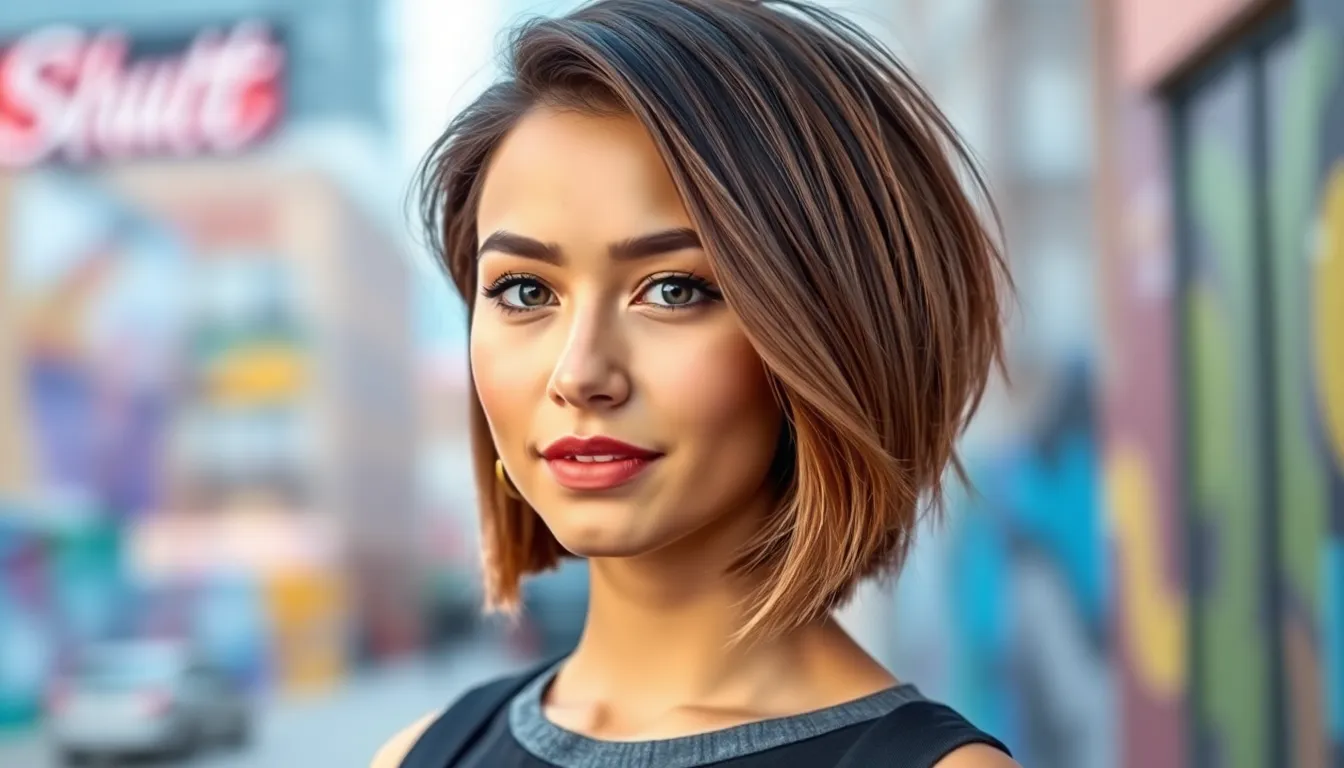
Asymmetrical bob styles represent the cutting edge of modern short bob hairstyles. These ever-changing cuts break traditional symmetry rules to create visually striking looks that command attention.
One-Side-Longer Design
Dramatic length differences create the foundation of asymmetrical bob styling, where one side typically extends 2 to 4 inches longer than the other. We recommend consulting with experienced stylists to determine optimal length ratios based on your face shape and personal style preferences. The longer side draws attention to exact facial features while the shorter side adds contemporary edge to your overall appearance.
Strategic placement of the longer section can enhance your best features and minimize areas you’d prefer to downplay. Stylists often position the extended length on the side of your natural part to maximize volume and movement. This placement technique works particularly well for clients with fine hair textures who want to create fuller looking styles.
Maintenance requirements for one side longer designs involve precise trimming every 6 to 8 weeks to preserve the intended proportions. Professional cutting ensures clean lines and prevents the style from appearing unintentionally grown out. We suggest taking reference photos to your appointments to maintain consistency between salon visits.
Artistic Hair Styling
Textural contrasts elevate asymmetrical bobs beyond simple length variations into true artistic expressions. Stylists incorporate techniques like razor cutting on shorter sections while maintaining blunt edges on longer areas. These mixed cutting methods create dimensional interest that catches light differently throughout your hair.
Color placement amplifies the artistic impact of uneven cuts through strategic highlighting and lowlighting techniques. Bold contrasts like dark roots with platinum ends emphasize the asymmetrical structure. Alternatively, subtle balayage techniques can add depth while maintaining natural looking movement.
Styling versatility allows artistic asymmetrical bobs to transform from edgy daytime looks to sophisticated evening styles. We achieve sleek professional appearances using flat irons and smoothing serums on both sections. Conversely, texturizing sprays and diffusing create casual tousled effects that highlight the cut’s inherent movement.
Celebrity Inspired Variations
Victoria Beckham’s signature asymmetrical bob popularized the dramatic side swept style that remains influential in contemporary hair fashion. Her version featured a steep angle with the front section reaching shoulder length while the back maintained a short pixie like cut. This extreme contrast created a bold statement that inspired countless variations.
Rihanna’s edgy interpretations showcased how asymmetrical bobs can incorporate bold colors and unconventional styling approaches. Her versions often featured undercut elements on the shorter side combined with vibrant hues like red, blonde, or even pink tones. These rebellious adaptations proved that asymmetrical cuts can serve as canvases for creative expression.
Modern celebrity updates continue to evolve the asymmetrical bob concept with subtle refinements and contemporary twists. Current variations often feature softer transitions between lengths and more wearable proportions. We observe trends toward incorporating face framing layers and lived in textures that make these styles more accessible for everyday wear.
Layered Bob: Building Volume and Dimension

Layered bobs transform flat hair into ever-changing styles through strategic cutting techniques that create movement and fullness. We’ll explore professional methods that maximize volume while maintaining the sophisticated bob silhouette.
Strategic Layer Placement
Interior layers create the foundation for volume without sacrificing the bob’s structural integrity. Professional stylists position these layers between 1 to 2 inches beneath the perimeter, allowing longer pieces to cascade over shorter ones naturally. Crown layering specifically targets the area where hair tends to lie flat against the scalp, lifting strands to create instant height and dimension.
Graduated cutting builds volume through systematic length variations that stack upon each other. We recommend requesting layers that graduate from shorter at the nape to longer toward the face, creating a cascading effect that naturally amplifies fullness. Weight removal in the interior sections eliminates bulk while preserving length, making thick hair more manageable and fine hair appear fuller.
Face framing layers add dimension around the perimeter while maintaining the bob’s classic shape. These strategic cuts should begin around cheekbone level, gradually blending into the overall length to create seamless transitions. Angular placement of these layers can enhance exact facial features while contributing to the overall volume structure.
Feathered Ends Technique
Point cutting creates feathered ends that add texture and movement to layered bobs without harsh lines. This technique involves cutting into the hair at various angles, creating soft, irregular edges that blend naturally and enhance volume. Razoring achieves similar results by thinning out the ends, allowing layers to separate and move independently.
Texturizing shears remove weight from the ends while creating subtle feathering that enhances the layered structure. Professional stylists use these specialized tools to create micro layers within each section, building dimension without compromising length. Slide cutting techniques allow for seamless blending between layers, creating graduated feathering that looks effortless.
Channel cutting involves creating small sections within each layer and cutting them at slight angles to promote separation and movement. This advanced technique requires precision but delivers exceptional results for building dimension in layered bobs. Notching the ends creates small indentations that help layers fall naturally while adding texture and visual interest.
Styling Tips for Fullness
Root lifting products applied to damp hair before styling create immediate volume at the scalp level. We recommend lightweight mousses and volumizing sprays that won’t weigh down fine hair or create buildup on thicker textures. Upside down blow drying amplifies the lifting effect, directing hair away from the scalp for maximum volume.
Round brush techniques enhance the layered structure by lifting each section while directing airflow for optimal volume. Use a barrel size that’s approximately half the length of your shortest layers to create proper tension and lift. Cool shot settings on blow dryers set the volume and help styles last longer throughout the day.
Texturizing sprays applied to dry hair enhance the separation between layers, making each one more visible and contributing to overall fullness. Dry shampoo serves dual purposes, absorbing excess oil while creating grip and texture that amplifies volume. Backcombing exact sections at the crown creates targeted lift without disturbing the layered silhouette.
Strategic product application ensures layers move independently while maintaining overall cohesion. Apply volumizing products primarily to the roots and mid lengths, avoiding the ends to prevent weighing down the feathered texture. Diffusing wavy or curly layered bobs enhances natural texture while building volume throughout the entire style.
Textured Bob: Creating Effortless Tousled Looks
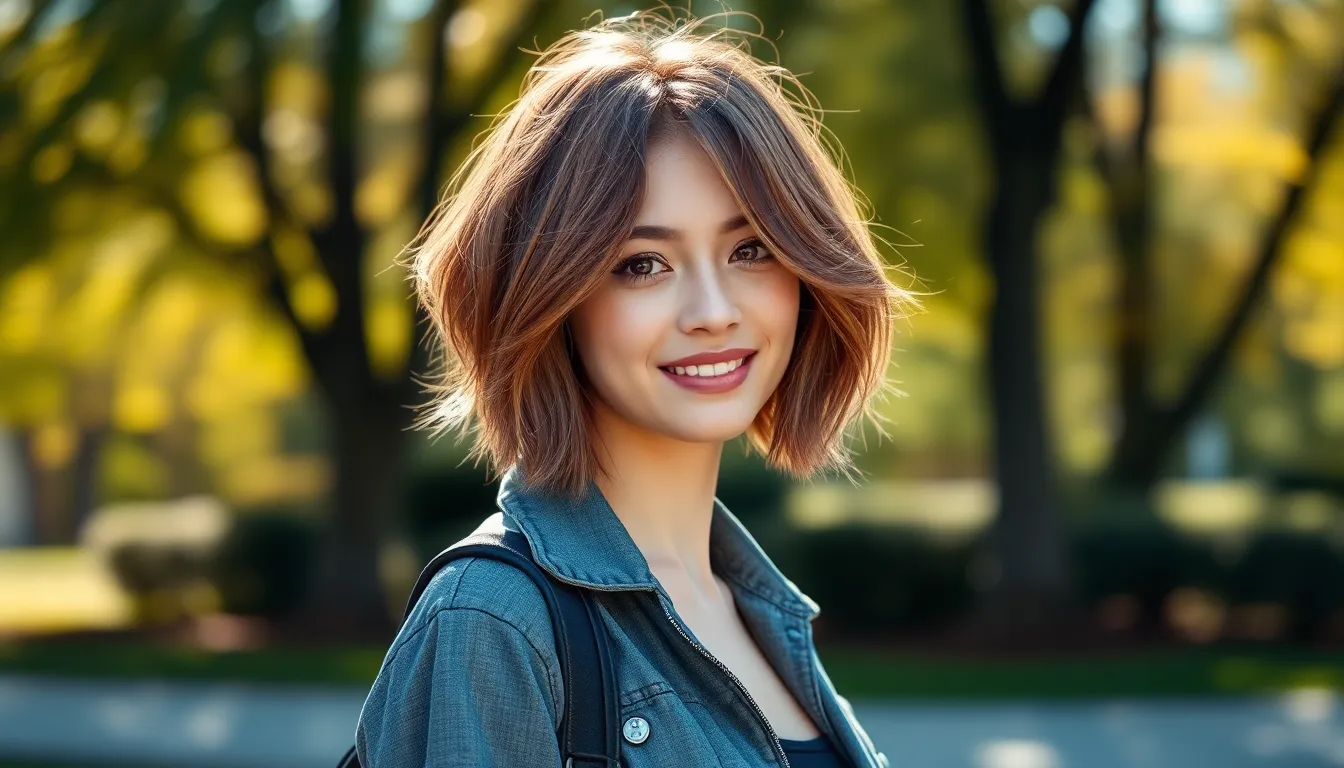
Textured bobs transform traditional smooth styles into ever-changing, lived-in looks that exude effortless sophistication. We’ll explore how strategic cutting and styling techniques create that coveted “just rolled out of bed” texture that looks intentionally undone yet perfectly polished.
Choppy Cut Benefits
Choppy cuts revolutionize short bob hairstyles by introducing deliberate unevenness that creates natural movement and visual interest. We recommend this technique for clients seeking low maintenance styles that still deliver high impact results.
Volume Enhancement occurs naturally when choppy layers remove weight from dense hair sections. Fine hair types gain instant fullness as shorter pieces lift longer sections, creating the illusion of thicker strands. Thick hair becomes more manageable as strategic choppy cuts reduce bulk while maintaining body.
Face Framing advantages emerge from choppy cuts that can be customized to highlight your best features. Angular cuts soften round faces by adding vertical lines, while curved choppy sections complement square jawlines. Heart shaped faces benefit from choppy pieces around the chin area that balance wider foreheads.
Styling Versatility expands dramatically with choppy textured bobs since each piece moves independently. Professional looks emerge when we smooth sections with lightweight serums, while casual styles develop naturally with minimal product manipulation. Evening glamour becomes achievable through strategic scrunching and texturizing sprays.
Growth Pattern management improves significantly with choppy cuts that disguise uneven growth between salon visits. Natural cowlicks blend seamlessly into intentionally uneven lengths, extending time between trims from 6 weeks to 8 weeks for most hair types.
Razor-Cut Techniques
Razor cutting creates the foundation for perfectly imperfect textured bob hairstyles that move naturally with your lifestyle. We prefer razor techniques over traditional shears for achieving authentic tousled textures that can’t be replicated through styling alone.
Point Cutting removes bulk while creating irregular edges that catch light beautifully throughout the day. Professional stylists angle razors at 45 degrees to slice through hair sections, creating soft transitions between lengths. This technique works exceptionally well on medium to thick hair densities that need weight removal without losing volume.
Slice Cutting involves drawing the razor vertically through hair sections to create internal texture and movement. We recommend this method for clients with naturally straight hair who struggle to maintain waves or curls. Results include natural looking separation that eliminates the flat, blunt appearance of scissor cut bobs.
Twist and Cut methods combine sectioning hair into small twists before razor cutting to create random, organic looking texture patterns. Each twist creates different length variations when unraveled, producing that sought after “messy chic” appearance. This technique requires 30 minutes additional cutting time but delivers 3 months of effortless styling.
Razor Maintenance requires exact aftercare to preserve the intentional texture and prevent unwanted frizz. Deep conditioning treatments every 2 weeks maintain moisture levels that razor cutting can temporarily reduce. Heat protectant products become essential for preserving razor cut integrity during styling.
Messy Styling Methods
Messy styling methods transform freshly cut textured bobs into perfectly imperfect masterpieces that look effortlessly chic. We’ve developed proven techniques that create intentional dishevelment without compromising the overall polished appearance.
Sea Salt Spray Application begins with damp hair and requires strategic sectioning for even distribution. Mix 1 tablespoon sea salt with 8 ounces warm water and add 1 teaspoon coconut oil for moisture balance. Spray from mid length to ends while scrunching sections upward to encourage natural texture development.
Finger Scrunching techniques activate natural wave patterns while creating separation between choppy pieces. Start with towel dried hair and apply lightweight mousse before gathering sections in your palms and squeezing upward. Release each section slowly to maintain the scrunched shape, repeating on all hair sections for consistent texture.
Twist and Air Dry methods work particularly well for fine to medium hair textures that need additional grip and hold. Divide damp hair into 6 sections and twist each piece away from your face before allowing natural air drying. Untwist when 90% dry and finger separate pieces for tousled volume.
Product Layering creates long lasting texture through strategic application of complementary styling products. Begin with volumizing mousse on roots, add texturizing cream through mid lengths, and finish with flexible hold hairspray misted from 12 inches away. This combination provides structure without stiffness.
Second Day Styling revitalizes textured bobs through targeted refreshing techniques that restore movement and separation. Lightly mist sections with water mixed with leave in conditioner, scrunch gently, and allow 10 minutes for natural texture reformation. Finish with dry texturizing spray for added grip and volume.
Bob with Bangs: Framing Your Face Perfectly
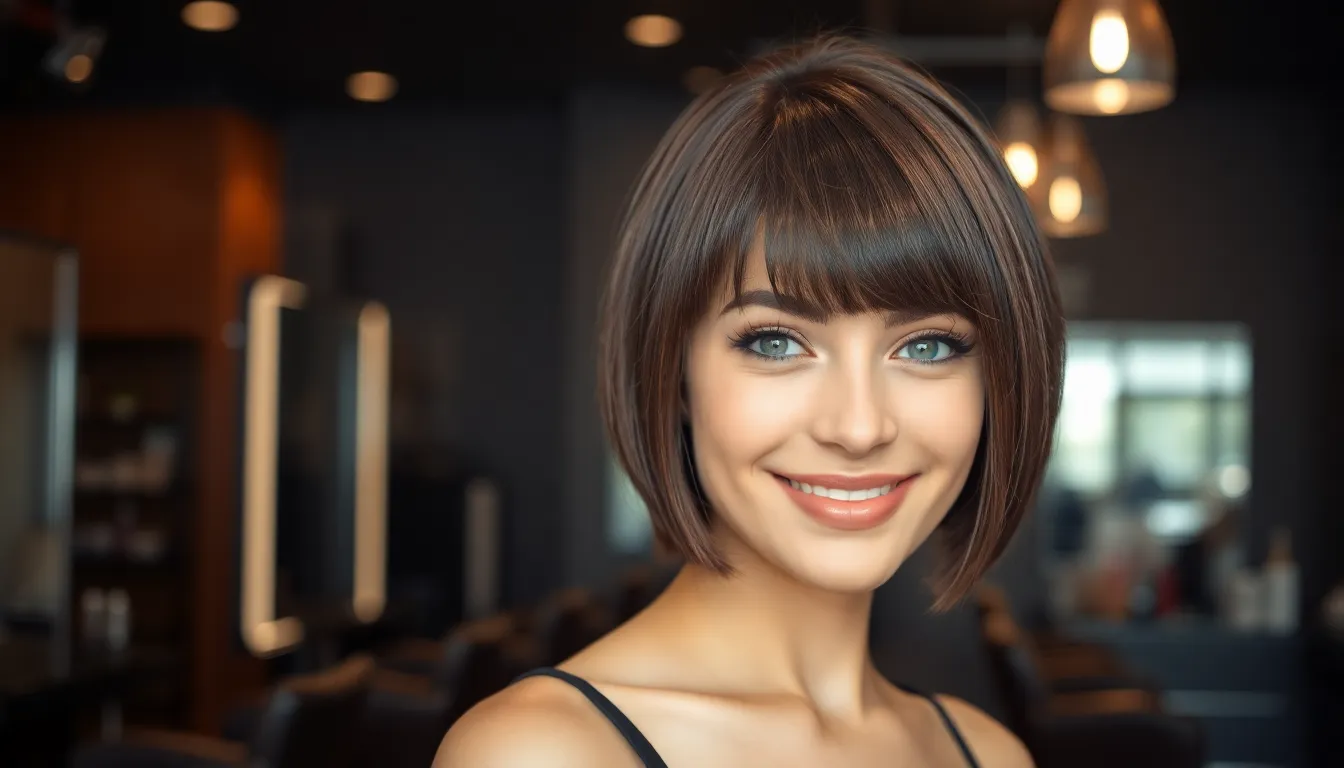
Bangs transform short bob hairstyles into face framing masterpieces that enhance facial features while adding personality and style. We’ve discovered that strategic fringe placement can balance proportions and create stunning focal points for any bob variation.
Blunt Bang Options
Blunt bangs deliver maximum impact when paired with short bob cuts through their clean horizontal lines that create striking contrast. These straight across cuts work exceptionally well with classic and A-line bobs measuring between 1.5 to 2 inches above the eyebrows. We recommend this combination for heart shaped and oval faces as it balances wider foreheads while emphasizing beautiful eyes.
Precision cutting techniques ensure blunt bangs maintain their sharp edges and dramatic effect throughout their growth cycle. Professional stylists use point cutting methods to create subtle texture within the solid line preventing harsh appearances. We’ve found that blunt bangs require trimming every 3 to 4 weeks to preserve their intended shape and proportions.
Dense fringe coverage creates bold statements when combined with sleek bob styles particularly on straight to slightly wavy hair textures. Thinning techniques help customize density levels for different hair types ensuring the bangs don’t overwhelm delicate facial features. We suggest using smoothing serums and flat ironing techniques to maintain the crisp lines that make blunt bangs so visually compelling.
Side-Swept Fringe Styles
Side swept bangs offer versatility and softness that complement virtually every short bob variation from classic to textured styles. These diagonal cuts typically extend from temple to temple creating natural movement that follows the hair’s growth patterns. We’ve observed that side swept fringes work beautifully on square and round face shapes by adding angular elements and visual length.
Layered cutting techniques create seamless blending between side swept bangs and the main bob structure ensuring natural transitions. Professional stylists use feathering methods to achieve the soft edges that make side swept styles so flattering and wearable. We recommend asking for longer pieces that can be tucked behind ears for styling flexibility and face shape customization.
Styling versatility makes side swept bangs particularly appealing for those who want fringe options without commitment to dramatic change. Different parting positions create varied looks from subtle face framing to more pronounced diagonal sweeps across the forehead. We suggest using lightweight mousses and diffusing techniques to enhance the natural movement while maintaining the soft romantic appeal.
Curtain Bang Combinations
Curtain bangs paired with short bobs create the perfect balance between retro charm and contemporary sophistication through their center parted styling. These face framing pieces typically measure 2 to 3 inches in length gradually blending into longer sections that frame the cheekbones. We’ve found this combination particularly flattering for long and diamond face shapes as it adds width and softness to angular features.
Graduated cutting techniques ensure curtain bangs flow seamlessly into layered bob structures creating cohesive styles that enhance natural hair movement. Professional installation involves precise sectioning and point cutting methods to achieve the signature separation and wispy texture. We recommend discussing desired density levels with your stylist as curtain bangs can be customized from subtle face framing to more dramatic volume depending on personal preference.
Modern styling approaches for curtain bang bobs include both smooth and textured techniques that adapt to various occasions and personal aesthetics. Blow drying with round brushes creates polished looks while scrunching methods enhance natural texture for effortless everyday styling. We suggest using texturizing sprays and light hold products to maintain the separated pieces while allowing for natural movement and touchable softness.
Maintenance Tips: Keeping Short Bob Hairstyles Fresh
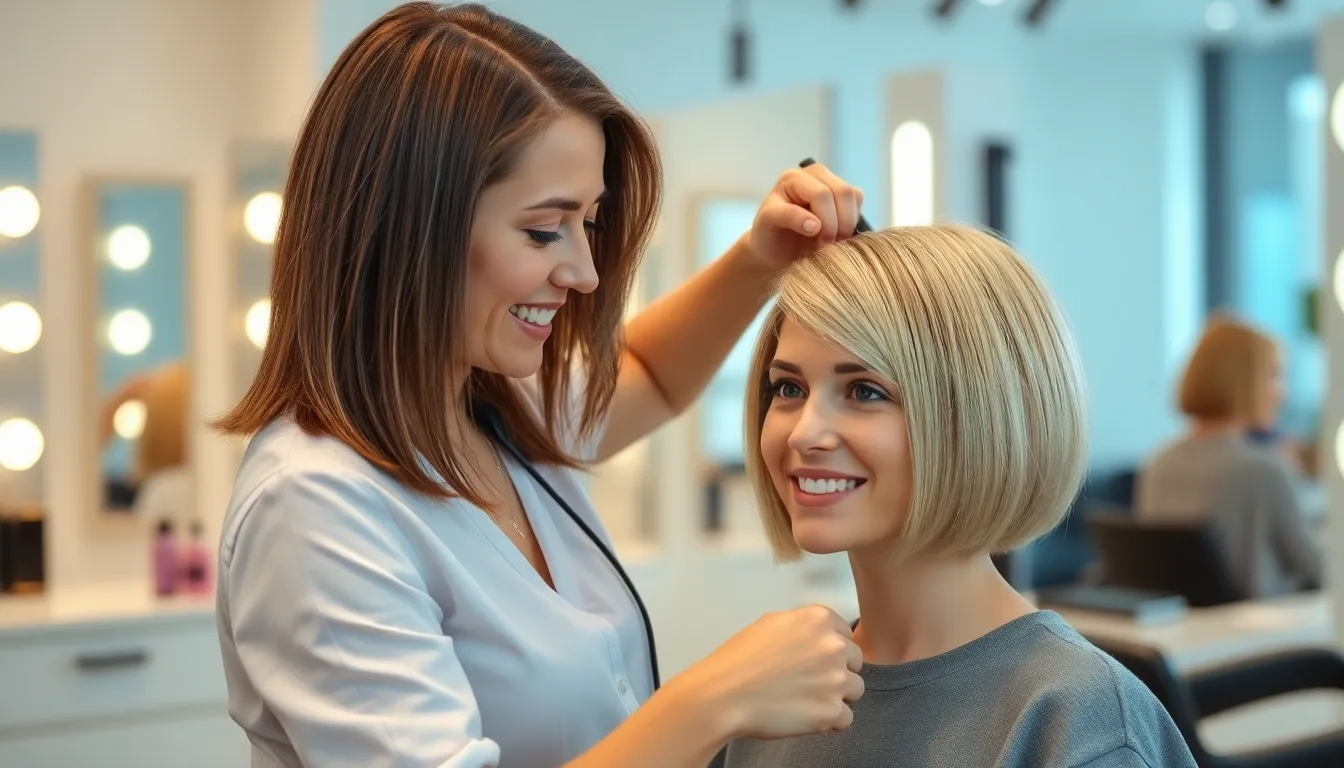
Short bob hairstyles require consistent upkeep to maintain their sharp, sophisticated appearance. We’ll share essential maintenance strategies that keep your bob looking salon fresh between appointments.
Regular Trim Schedule
Schedule appointments every 4 to 8 weeks depending on your exact bob variation and growth rate. Classic and A-line bobs typically need refreshing every 6 to 8 weeks, while pixie bobs require more frequent visits every 4 to 6 weeks to maintain their precise shape.
Track your hair’s growth patterns to determine your optimal trimming frequency. Fine hair often needs attention every 5 weeks, whereas thicker hair can extend to 7 or 8 weeks between cuts. Inverted bobs with stacked layers demand the most precision, requiring touch-ups every 5 to 7 weeks to preserve their dramatic silhouette.
Mark calendar reminders to prevent your bob from losing its intended shape. We recommend booking your next appointment before leaving the salon to secure consistent maintenance timing. Growth beyond your scheduled trim window can compromise the bob’s structural integrity and styling ease.
At-Home Styling Techniques
Apply lightweight styling products to damp hair before blow-drying to create lasting foundation. Volumizing mousses work excellently for fine hair bobs, while smoothing creams tame thick, textured cuts without weighing them down.
Use round brushes during blow-drying to maintain your bob’s natural curve and add subtle lift at the roots. We suggest 2-inch barrel brushes for classic bobs and smaller 1-inch brushes for pixie variations to achieve optimal shaping control.
Carry out the cool shot setting on your blow dryer to lock in your styled shape and boost shine. This final step seals the hair cuticle and extends your style’s longevity throughout the day.
Sleep on silk pillowcases to reduce friction and maintain your bob’s smoothness overnight. Alternatively, wrap your hair in a silk scarf or use a silk bonnet to prevent morning tangles and preserve your styling efforts.
Refresh second-day styles with dry shampoo at the roots and a light misting of texturizing spray through the mid-lengths. This combination revives volume and adds grip for easier restyling without washing.
Professional Touch-Up Recommendations
Communicate changes in your lifestyle to your stylist during appointments to adjust your bob accordingly. Active schedules may benefit from slightly shorter lengths, while professional environments might require more polished finishing techniques.
Request exact layering adjustments based on how your bob grows out between visits. We’ve found that asking for interior texturizing can extend the time between cuts while maintaining movement and shape.
Consider seasonal modifications to your bob maintenance routine with professional guidance. Summer humidity may require different cutting techniques, while winter dryness might need adjusted styling product recommendations.
Book color touch-ups strategically with your trim schedule to maximize salon efficiency. Highlights, lowlights, or single-process color should align with your cutting appointments to maintain cohesive bob styling.
Ask for at-home styling demonstrations during your salon visits to master new techniques. Most stylists willingly show exact blow-drying methods or product application tips that work best with your particular bob variation and hair type.
Conclusion
Short bob hairstyles continue to reign as one of our most beloved hair trends for good reason. Whether you’re drawn to the timeless elegance of a classic bob or the edgy sophistication of an asymmetrical cut these versatile styles adapt beautifully to your unique personality and lifestyle needs.
We’ve seen how each variation offers its own distinct advantages from the volume-boosting A-line to the low-maintenance pixie bob. The key to success lies in choosing the right style for your face shape hair texture and daily routine.
Ready to make the chop? We recommend consulting with a professional stylist who can help you select the perfect short bob variation and create a maintenance schedule that keeps your new look fresh and fabulous. Your hair transformation awaits!
Frequently Asked Questions
What is a short bob hairstyle and who can wear it?
A short bob is a chin-length haircut that combines sophistication with effortless style. It’s versatile enough to flatter various face shapes and can be customized from sleek to textured looks. Whether you have fine or thick hair, there’s a short bob variation that can enhance your natural features and suit your lifestyle.
How often should I trim my short bob to maintain its shape?
Trim frequency depends on your specific bob style. Classic and A-line bobs need maintenance every 6 to 8 weeks, while pixie bobs require more frequent visits every 4 to 6 weeks. Inverted bobs with stacked layers should be trimmed every 5 to 7 weeks to maintain their precise silhouette and volume.
What’s the difference between an A-line bob and a classic bob?
An A-line bob features graduated layers with the back shorter than the front, creating dimensional movement and natural volume. A classic bob maintains uniform length around the perimeter with a chin-length precision cut. The A-line variation offers more movement and is particularly flattering for round faces.
Can I style a short bob for both professional and casual occasions?
Absolutely! Short bobs are incredibly versatile. Use smoothing products and round brush techniques for sleek, professional looks, or apply texturizing products and scrunch for casual, tousled styles. The same bob can transition from boardroom to weekend with simple styling adjustments and different product applications.
Are short bobs suitable for different hair textures?
Yes, short bobs work beautifully with various hair textures. Fine hair benefits from A-line cuts that create fullness illusion, while thick hair enjoys reduced bulk through layering. Wavy hair can enhance the bob’s natural movement, and straight hair showcases clean lines perfectly. Styling techniques can be adapted accordingly.
What bangs work best with short bob hairstyles?
Several bang styles complement short bobs: blunt bangs create striking contrast, side-swept fringes add softness and versatility, and curtain bangs offer modern sophistication. The choice depends on your face shape, lifestyle, and personal preference. Each style requires specific maintenance and styling techniques for optimal results.
How do I add texture to my bob without damaging my hair?
Use texturizing techniques like point cutting, razor cutting, and strategic layering during professional cuts. For daily styling, apply sea salt spray to damp hair and scrunch, or use lightweight texturizing products. Avoid over-processing and always use heat protectants when styling with hot tools.
What products should I use to maintain my short bob at home?
Essential products include lightweight volumizing mousse for lift, smoothing serums for sleek styles, texturizing sprays for movement, and heat protectants for styling tools. Use round brushes for blow-drying, and consider silk pillowcases to preserve your style overnight. Quality products prevent buildup while maintaining your bob’s shape.

